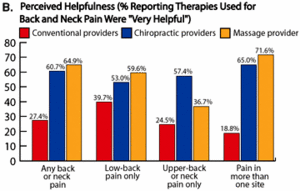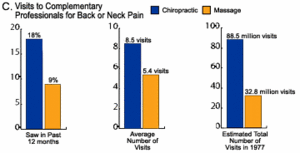The survey was conducted to "assess therapies used to treat back or neck pain." The authors found that 33% of U.S.
The study goes on to compare various forms of "complementary" versus "conventional" care. The most interesting results involve use and patient satisfaction: (see graph A.)
Interestingly enough, more people saw a "complementary" provider for neck pain and complicated pain that a medical provider. Medical providers actually saw 50 percent more back-pain patients than did complementary providers. (see graph B.)
Chiropractic providers were considered "very helpful" by approximately twice as many patients as medical providers. But even more patients deemed massage "helpful" for all but neck and upper back pain where chiropractors remained dominant. (see graph C.)
DCs enjoyed a 2-to-1 margin over massage therapists in terms of the number of back- and neck-pain patients they saw; the margin was even greater for the estimated total number of visits for 1997.
The authors also make the following point:
"Complementary professionals combined to provide an estimated 203 million visits specifically for the treatment of back and neck pain in 1997, leaving only 426 million complementary professional visits for all other purposes combined. By comparison, in 1997 there were approximately 386 million visits to all primary care physicians for any reason at all."
This last comment reflects the proverbial "pie" carved up annually between providers. (Needless to say, this does not take into consideration over-the-counter [OTC] drugs, vitamins and other forms of care that do not require a visit to a provider.) There were only 1,015 million visits to providers of any kind in 1977. Back and neck pain resulted in 203 million visits to complementary providers (20% of all visits), of which 88.5 million visits were to doctors of chiropractic (8.7% of all visits).
Given this reality, the only way for chiropractic to grow at a greater rate than the population is to take some of these visits away from medical or other complementary providers.
Given the sorry percentage of patients that found MDs "very helpful" for back and neck pain, this is the first place chiropractic should focus to gain market share. We obviously do it better, and should be allowed to care for those patients first. However, chiropractic must also be mindful of the inroads being made by other nonmedical providers. As their numbers continue to swell, the competition for a bigger slice of the "pie" will continue to intensify.
References
- Wolsko PM, Eisenberg DM, Davis RB, et al. Patterns and perceptions of care for treatment of back and neck pain. Spine 2003:28, pp292-98.
- Eisenberg DM, Kessler RC, Foster C, et al. Unconventional medicine in the U.S. - prevalence, costs and patterns of use. N Engl J Med 1993:328, pp246-52.
- National survey shows alternative health care on the rise. Dynamic Chiropractic, March 12, 1993. www.chiroweb.com/archives/11/06/14.html.
- Eisenberg DM, Davis RB, Ettner SL, et al. Trends in alternative medicine use in the United States, 1990-1997. JAMA 1998:280, pp1569-1575.
- Alternative no more. Dynamic Chiropractic, Jan. 1, 1999. www.chiroweb.com/archives/17/01/10.html.
DMP Jr.
Click here for more information about Donald M. Petersen Jr., BS, HCD(hc), FICC(h), Publisher.








